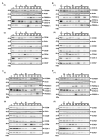Levels of Coenzyme Q10 and Several COQ Proteins in Human Astrocytoma Tissues Are Inversely Correlated with Malignancy
- PMID: 35204836
- PMCID: PMC8869183
- DOI: 10.3390/biom12020336
Levels of Coenzyme Q10 and Several COQ Proteins in Human Astrocytoma Tissues Are Inversely Correlated with Malignancy
Abstract
In a previous study, we reported the alterations of primary antioxidant enzymes and decreased citrate synthase (CS) activities in different grades of human astrocytoma tissues. Here, we further investigated coenzyme Q10 (CoQ10) levels and protein levels of polyprenyl diphosphate synthase subunit (PDSS2) and several COQ proteins required for CoQ10 biosynthesis in these tissues. We found that the level of endogenous CoQ10, but not of exogenous α-tocopherol, was higher in nontumor controls than in all grades of astrocytoma tissues. The levels of COQ3, COQ5, COQ6, COQ7, COQ8A, and COQ9, but not of COQ4, were lower in Grade IV astrocytoma tissues than in controls or low-grade (Grades I and II) astrocytomas, but PDSS2 levels were higher in astrocytoma tissues than in controls. Correlation analysis revealed that the levels of CoQ10 and COQ proteins were negatively correlated with malignancy degree and positively correlated with CS activity, whereas PDSS2 level was positively correlated with malignancy. Moreover, lower level of mitochondrial DNA-encoded cytochrome c oxidase subunit 2 was not only associated with a higher malignancy degree but also with lower level of all COQ proteins detected. The results revealed that mitochondrial abnormalities are associated with impaired CoQ10 maintenance in human astrocytoma progression.
Keywords: COQ proteins; COX II; PDSS2; astrocytoma; citrate synthase; coenzyme Q10; malignancy.
Conflict of interest statement
All the authors declare no conflict of interest.
Figures




Similar articles
-
Characterization of human mitochondrial PDSS and COQ proteins and their roles in maintaining coenzyme Q10 levels and each other's stability.Biochim Biophys Acta Bioenerg. 2020 Jul 1;1861(7):148192. doi: 10.1016/j.bbabio.2020.148192. Epub 2020 Mar 17. Biochim Biophys Acta Bioenerg. 2020. PMID: 32194061
-
Alterations in coenzyme Q10 status in a cybrid line harboring the 3243A>G mutation of mitochondrial DNA is associated with abnormal mitochondrial bioenergetics and dysregulated mitochondrial biogenesis.Biochim Biophys Acta Bioenerg. 2024 Nov 1;1865(4):149492. doi: 10.1016/j.bbabio.2024.149492. Epub 2024 Jul 1. Biochim Biophys Acta Bioenerg. 2024. PMID: 38960080
-
Primary Coenzyme Q10 Deficiency Overview.2017 Jan 26 [updated 2023 Jun 8]. In: Adam MP, Feldman J, Mirzaa GM, Pagon RA, Wallace SE, Amemiya A, editors. GeneReviews® [Internet]. Seattle (WA): University of Washington, Seattle; 1993–2025. 2017 Jan 26 [updated 2023 Jun 8]. In: Adam MP, Feldman J, Mirzaa GM, Pagon RA, Wallace SE, Amemiya A, editors. GeneReviews® [Internet]. Seattle (WA): University of Washington, Seattle; 1993–2025. PMID: 28125198 Free Books & Documents. Review.
-
Disruption of the human COQ5-containing protein complex is associated with diminished coenzyme Q10 levels under two different conditions of mitochondrial energy deficiency.Biochim Biophys Acta. 2016 Sep;1860(9):1864-76. doi: 10.1016/j.bbagen.2016.05.005. Epub 2016 May 4. Biochim Biophys Acta. 2016. PMID: 27155576
-
Neuroimaging in Primary Coenzyme-Q10-Deficiency Disorders.Antioxidants (Basel). 2023 Mar 14;12(3):718. doi: 10.3390/antiox12030718. Antioxidants (Basel). 2023. PMID: 36978966 Free PMC article. Review.
Cited by
-
Neuroprotective effects of coenzyme Q10 on neurological diseases: a review article.Front Neurosci. 2023 Jun 23;17:1188839. doi: 10.3389/fnins.2023.1188839. eCollection 2023. Front Neurosci. 2023. PMID: 37424991 Free PMC article. Review.
-
Novel mitochondrial-related gene signature predicts prognosis and immunological status in glioma.Transl Cancer Res. 2024 Jul 31;13(7):3338-3353. doi: 10.21037/tcr-23-2072. Epub 2024 Jul 26. Transl Cancer Res. 2024. PMID: 39145059 Free PMC article.
References
Publication types
MeSH terms
Substances
LinkOut - more resources
Full Text Sources
Molecular Biology Databases

